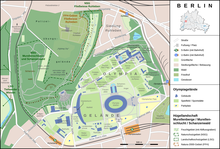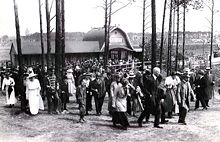Olympia-Stadion underground station
The Olympia-Stadion underground station is a station on the U2 line of the Berlin underground . It is located in the Westend district of Berlin and also houses the U-Bahn Museum ; The Grunewald workshop is located nearby .
history
At the Olympia-Stadion underground station, passengers were welcomed for the first time on June 8, 1913, under the name of the stadium at the time, as Kaiser Wilhelm II opened the nearby German stadium on that day . The elevated railway company , which operated the elevated and underground lines in Berlin at the time, only operated the station irregularly over the next few months. The trains only drove over the Reichskanzlerplatz for special events such as horse races . The station itself consisted of a simple central platform with two tracks and a small, wooden entrance building, designed by the Swiss architect Sepp Kaiser .
The first regular operation began in 1922, when the Neu-Westend train station was opened between the Stadion and Reichskanzlerplatz stations . Its construction had already been prepared in 1913, the sparse settlement did not yet justify the expansion. Seven years later, Berlin was a candidate city for the 1936 Olympic Games , so Alfred Grenander was commissioned to redesign the station. He designed a completely new entrance building, which was provided with red bricks . This in turn is at right angles to the tracks, for which the BVG again had two platforms built. At the same time, a large signal box, which was still hand-operated at the time, went into operation, with a total of 109 points and 99 signals. At that time, the interlocking with its 616 possible routes to be set was considered the largest electromechanical interlocking of its type in all of Europe.

Since December 22, 1929, the station was no longer the terminus; this was now taken over by the Ruhleben station, 1200 meters away. The Stadion station was named Reichssportfeld in the run-up to the Olympic Games . During these Olympic Games, the U-Bahn line A, together with the S-Bahn, handled the traffic to the Olympic Stadium, among other places . In the Second World War , which began three years later , considerable damage occurred, including the Reichssportfeld train station . On February 15, 1944, an air mine hit the entrance building and caused considerable damage. Nevertheless, the section of underground line A in the direction of Ruhleben was one of the most intact underground lines until recently. Operations ceased on April 25, 1945 at the latest.
The first trains were able to run again soon after the war, and on the relevant section between Ruhleben and Kaiserdamm , trains had been in shuttle service again since May 17th. This could be expanded over the next few weeks and months, so that from September 15, 1946, continuous operation was possible again without changing between Pankow and Ruhleben. After the Federal Republic of Germany was founded in 1949, the station was given the new name Olympia-Stadion on June 26, 1950 .

From November 1956, there were no longer any trains going directly to Pankow, as line A I was shortened to today's Theodor-Heuss-Platz and a new line called AB I was installed, which was called line B I from May 1957 . This changed behind the Wittenbergplatz U-Bahn station on the relief route towards Warschauer Brücke . Due to the construction of the Wall in 1961, it ended in Kreuzberg at the Schlesisches Tor station . From 1966 this became known as 'Line 1'; 1984 to the 'U1 line'. From 1993 this line was designated as ' Line U12 '.
Since 1993 the U2 line has been running from here in the direction of Pankow . A year earlier, the station was briefly named Olympia-Stadion (East) . This only lasted from May 31, 1992 to May 31, 1999, since then the station has been called the Olympic Stadium again . The only difference to the S-Bahn station of the same name , which is more than 500 meters away, is the hyphen between the words, the S-Bahn station is called Olympiastadion .
In preparation for the 2006 soccer World Cup , the BVG, together with the federal and state governments, invested a total of 4.47 million euros in the renovation of the underground station, which, as one of the two stadium stations, served as a meeting point for some soccer enthusiasts. Together with the U2 subway line, it was part of the traffic concept for the World Cup; during the season, the trains ran every 2 to 3 1 ⁄ 2 minutes. The renovation of the train station in accordance with the requirements of historical monuments , which took 20 months due to a severe winter, included, among other things, the refurbishment of the entrance building and equipping it with a guidance system for the blind . The station also received two elevators for accessibility , which are connected by a bridge to Rossiter Platz, the forecourt of the station. In addition, at the request of the Hertha BSC football club , which is based in the Olympic Stadium, the BVG had the supports painted blue in the club's color.
The Grunewald workshop for the small-profile lines of the Berlin subway is also located at the Olympia-Stadion station.
- → For more information, see the Grunewald workshop
The hand-lever interlocking there has been out of service since 1983 and was replaced by a lane plan interlocking on behalf of the BVG. Thanks to the commitment of individual employees of the transport company, the building, which was actually intended for demolition, was retained and a small, previously non-existent underground museum was built. Much of the signal box can still be viewed by museum guests today. The museum also has numerous small exhibits such as destination displays, old photographs and network maps.
Connection
The underground station serves primarily to connect the Olympic Stadium to Berlin's local transport network . There is no direct transfer from the U2 line to other public transport.
Web links
- BVG map of the station (PDF; 148 kB)
- Description of the underground line at berliner-untergrundbahn.de
- Website of the underground museum
- Olympia-Stadion underground station . In: District lexicon of the Luisenstädtischer Bildungsverein
- Entry in the Berlin State Monument List
Individual evidence
- ^ Eva Dorothée Schmid: With elevators and guidance system for the blind . In: Berliner Zeitung , June 1, 2006
- ↑ Description of the museum
Coordinates: 52 ° 31 ′ 2 ″ N , 13 ° 15 ′ 0 ″ E




